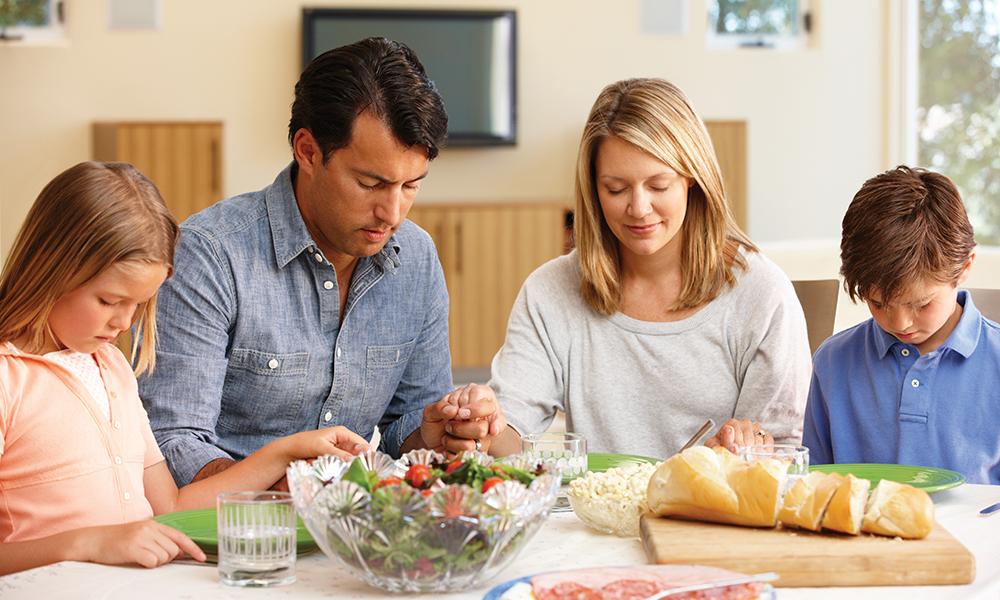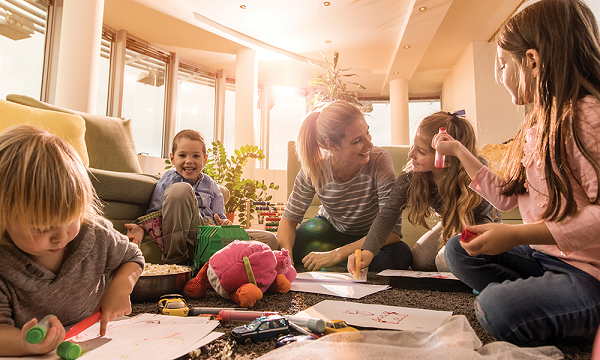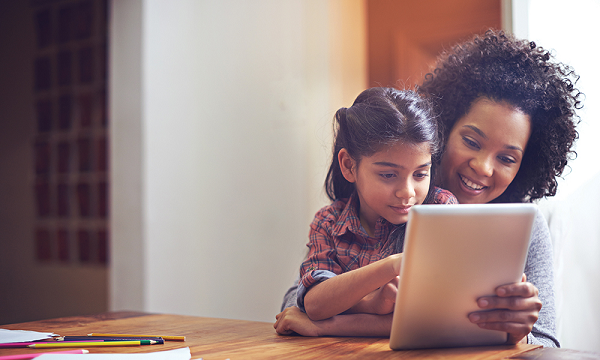
School at Home Guide for Catholic Families
Relax — you’re already a religion teacher!
Without the support of Catholic school religion classes or parish religious education programs, many parents are concerned about how to “teach religion” during the mandated period of social distancing. In fact, for many parents, the idea of holding at-home religion classes makes them feel inadequate, since few Catholics have formal training in theology.
There’s good news about teaching the Good News! You don’t need a degree in theology. You need only to remember that your family represents a domestic Church, and your role is to lead your flock toward a closer relationship with Jesus Christ. We know that times of crisis often serve as a catalyst to growing in faith. Catholic educators recommend responding to the COVID-19 public health crisis by demonstrating to children the vital role your faith plays in your daily life. You’ll be teaching by example, and your lessons may make a lasting impression that could inspire your children for years to come.
While you’re at home with your kids, try these ideas to practice and demonstrate the faith:
• Connect with your parish online for Mass. If your parish isn’t streaming Sunday Mass, visit watchthemass.com for live and taped Masses. As you would on Sunday, gather the family together, sit respectfully as you watch the liturgy, pray along (but no need to stand or kneel), and say a prayer of spiritual Communion in lieu of receiving the Eucharist.
• Pray together as a family. Take turns reading the daily Scripture aloud and have an informal Bible study over breakfast, discussing what the readings reveal to you that day.
• During family prayer, include your own version of the prayers of the faithful with prayer intentions from
each family member. In particular, pray for:
• The Church, Pope Francis, all the clergy, and especially for our pastor and parish staff
• Those who are leading nations, states and communities through the COVID-19 crisis
• Health care workers
• Those who are sick and suffering, and their families, and those with other health issues whose treatments are being affected by the crisis
• Those who are dying and who will die alone, and for their families
• Pray a family rosary and have each member lead a decade, and everyone shares intentions.
• Have a crucifix in a prominent place in the home,
and in every bedroom. If your children don’t have them, make them as a craft project during school-at-home.
• Talk freely about the presence of God during these uncertain days. When reading the news, look for uplifting stories of neighbors helping neighbors, heroic health care workers, and others who demonstrate sacrificial love.
• Allow your children to witness you in private prayer. Encourage your children to pray daily on their own, to listen for God’s call, and, if heard, to respond. Order a prayer journal online for each family member.
• For more ideas on how to build your home as a Domestic Church, visit www.kofc.org/un/en/resources/programs/family-fully-alive/10162-family-fully-alive-booklet.pdf sponsored by the Knights of Columbus.
Organize the day for school-at-home
When you’re teaching at home, you’ll be more successful if you abandon the idea of replicating a regular school day and, instead, create an easy-to-learn routine. Imagine the day in blocks, divided by mealtimes that create natural breaks. Meals could be the anchors attached to the clock, since setting a designated breakfast, lunch and dinner time can help manage childrens’ expectations. Activities in between can be fluid to reflect that varying amount of time children need to accomplish the day’s goals. (Note: experienced homeschoolers say the kitchen should be “closed” between meals, to keep from daylong grazing that isn’t healthy and can get expensive.)
Up and at ‘em!
While you don’t have to set the alarm for an early start as you would for a typical school day, establish a routine by choosing a regular time to start the day. Student athletes might begin with a short workout. Morning chores include making beds, picking up clothes, brushing teeth and getting dressed for the day. Children also can help the household by folding laundry, emptying the dishwasher, and walking the dog.
Breakfast and Planning
Whether breakfast is a communal meal fixed by mom or another family member, or everyone prepares their own, begin the routine by sitting down together to pray, eat, and map out the day. Imagine this as a “team meeting” where the game plan is chalked out. Each child should leave the table with a list of tasks that needs to be accomplished during the day, as well as a review of longer-term assignments that might be worked on, but not completed. When the dishes are cleared and the table is clean, it’s time to start school.
Flexible schoolwork in the morning
Students in grades five through eight are capable of a fair amount of self-directed learning, especially in literature-based courses. For assignments that involve reading from textbooks or novels, they may only need a few minutes with a parent for direction. Depending on the number of children engaged in school-at-home, parents can decide to spend blocks of time with each one individually throughout the day, working on several subjects during their one-on-one time. In addition, since several children at home may be sharing a computer, the day may look different for each child — one may be working on schoolwork for the morning while another enjoys playtime until the laptop is free.
Participate in online learning
During this unprecedented public health crisis, schools have rallied to offer continuity of learning plans and online learning opportunities for students. Many teachers are sending daily emails with assignments that are due online. Whether they’re joining a Facebook Live class or watching a lesson previously recorded and posted to YouTube, students will likely be engaged with technology for big chunks of the day. For this reason, it’s even more important that children enjoy tech-free recreation when their schoolwork is done.
Playtime, exercise, games, music, and more
The school-from-home day ends much sooner than a typical school day, since working independently on assignments takes less time without the elements of structure that a school day requires. The result? You may announce “Class dismissed!” just in time for lunch, leaving the afternoon open for free play, board games, exercise, practicing an instrument, or engaging in a hobby. Keep in mind that fifth- through eighth-graders are extremely social creatures who need to keep up with friends through texts, calls and social media. Having time for this is a great incentive for a productive morning of schoolwork.
Make school-at-home memorable and fun for Kindergarten — fourth graders
Years from now, younger children may not remember everything about the 2020 school year, when coronavirus disrupted the world and sent them home for weeks of remote learning. But they may recall the memorable things their parents did to make the experience both educational and fun. Use these tips to harness the energy and curiosity of early-grade students:
Get moving!
- If weather allows:
- Go outside and use nature to help you learn
- Create a scavenger hunt
- Take a walk and talk about God’s creation
- Work on gross motor skills by setting up a mini obstacle course, hopscotch, throw/kick a ball
- Use sidewalk chalk to practice name writing, numbers and/or drawing
If weather is not ideal, adapt to the indoor environment:
- Play tennis with paper plates and a balloon
- Jump rope in the basement
- Sort/build with Legos
- Do science experiments inthe kitchen
- Watch GoNoodle Movement and mindfulness videos at www.gonoodle.com
Take brain breaks.
- Play music and freeze dance
- Do an online exercise class
- Play Sparkle with counting or spelling words
- Cook or bake together
- Play board games, do a puzzle, paint or draw
Use technology productively.
- Use online resources like ABCya, BrainPOP, ABC Mouse or Catholic Brain
- Use FaceTime, Facebook Live or Zoom to connect with teachers and school friends
- Since screen time use will go up for online learning, try to limit recreational screen time
Encourage self-directed learning.
- Set up devoted spaces in your home for hands-on learning
- Set out sensory bins, blocks, Play Doh, coloring sheets, etc. for free play
- Let your child help to determine the schedule for the day
- Post a checklist on the fridge for your child to track his or her own progress on assignments
- Create Catholic crosswords and word search games online at wordmint.com
Go on a virtual field trip!
- Lunch Doodles with Mo Willems — Kennedy Center www.kennedy-center.org/education/mo-willems
- Daily animal visits and crafts from the Cincinnati Zoo and St. Louis Aquarium
- Live webcams and STEM activities from NASA
- Virtual museum tours, such as the White House or the Vatican!
Dos and Don’ts for high-school-at-home
Do make a schedule. Without the threat of tardies and detention, high-schoolers studying at home might not start their day until 11 a.m., but they can still have a schedule to help them feel secure. Set specific times for breakfast (or brunch!), lunch and dinner. Include times for online learning, homework, chores and socializing.
Do encourage your teen to get dressed, even if it’s switching from PJs to sweatpants. It might feel like an extended weekend, but online learning often includes video conferencing and virtual classrooms with students looking at each other and their teacher. Putting on an outfit that might normally be worn to hang out with friends, or go to practice, lets their brain know it’s time to wake up.
Do let your student talk to their friends. Whether through phone calls, FaceTime, a video conference, or interactive video games, find a way you are comfortable with for them to communicate with other students their age. Remember, most students are used to being with friends anywhere from seven to 12 hours a day (including after school activities and practice times). Letting them blow off some steam with friends suffering through the same circumstances can boost their mood and make them feel less isolated.
Do make sure you are connecting as a family during this time. It’s easy for everyone to be on their individual electronic devices, talking online to friends and doing their homework in isolation. Gather together at least once a day without electronics in a relaxed setting to eat, joke, share concerns, pray and express gratitude. You have a captive audience, it’s a great time for family movie nights and to share your favorite cookie recipes. When you make the cookies, eat them together!
Do pray for guidance. When you catch yourself being caught up in the stress of work and school and everything that usually happens in separate places, all going on at your kitchen island or dining room table, take a deep breath and ask the Holy Spirit to show you the next right thing you can do to keep your family moving in the right direction in this uncharted territory.
Don’t be too hard on yourself if your kids don’t keep their schedule. There will be another day to get yourself, and your teenager, back on track. With the uncertainty and anxiety over the coronavirus pandemic, you are teaching your child that it is OK to take a moment, or the day, to let yourself relax, be still, and find peace by just being together.
Don’t do the hard work for them. High school teachers and administrators often set up situations that are designed to encourage the students to be independent and responsible for their own work. Make sure that you are doing the same.
Don’t expect perfection, from yourself or your teen. Don’t put too much pressure on yourself to become a teacher or expert overnight on the subjects your teen is learning. Many teachers are offering online office hours and encourage students to ask them questions and discuss potential learning difficulties. If your child is struggling, encourage him or her to contact the teacher and seek out online educational resources.
Don’t forget to have compassion. Our students are critically aware of the unprecedented times they are living through. Many are mourning the loss of abandoned sports seasons, prom dates, daily interaction with friends and favorite teachers and maybe even their high school graduation. Now is the time to pray for patience, wisdom and the ability to understand there could be a real reason for all that teenage angst.
Lansing Superintendent Tom Maloney offers advice to parents teaching at home
The Catholic Church has always said that parents are the primary educators of their children,” says Diocese of Lansing school superintendent Tom Maloney. “Our role has been to partner with parents, but now that partnership is taking on a different look. As they say, things are getting real right now.”
Maloney oversees 32 diocesan schools, including four high schools, comprising nearly 7,400 students, who are all engaged in remote learning from home right now. “Our schools are doing a combination of online and distance learning. Most of our teachers use a platform to interact with students directly and almost all of our students are equipped with the technology for distance learning, either personal devices or school-provided devices,” Maloney explains. “Schools are relying on paper packets for some of the younger students. But either way, our students are continuing their education and formation at home, and this is only possible because of the great dedication and commitment of our teachers and administrators, and because of the true partnership we enjoy with our families.
As always, our mission is to support our faith, our families, and our friendships. And I think we’re finding creative and effective ways to do that.
Maloney understands the challenges the COVID-19 crisis has created for families. “Of course, parents are their children’s ‘first teachers,’ but that said, they’re not used to being the day-to-day instructors of their children. So our teachers are really helping them, giving parents some tricks of the trade to help them deliver content. They’re suggesting schedules that include time for prayer and play.” Maloney stresses that social isolation is a real concern, and recommends parents find ways to keep their children connected with teachers.
“Applications like Zoom are great for teachers to hold office hours, where students can join in and see their teachers and schoolmates on screen. This helps them to see that everyone is alright. Children want to know that their teachers are OK during this crisis.”
What happens if school-at-home is extended for a long period of time, potentially for the remainder of the school year? “We have to continue to support parents with content and pedagogy — ‘the how’ of teaching,” Maloney says. His advice to parents: “Don’t be too hard on yourself. You’re probably not used to this. It’s new to you, and it’s going to be messy at home, figuratively and literally. But, over time, you’ll develop a routine. Once families get past the ‘snow day’ mentality, where this seems like a novelty, they’ll create systems for study, prayer, family time and play time.”
Maloney encourages parents to post the daily routine on the fridge, communicate with teachers regularly via email and don’t be afraid to rely on them. “Our teachers know your children and can give you insight,” he says.
“As always, Catholic education is a partnership between parents and Catholic schools,” Maloney says. “This is a new and very different way of living out that partnership, but our mission is the same — to build both scholars and saints. If we work together, we’ll get through this and we’ll be stronger for the experience.”
School-at-home can be fun with the help of online resources
Most teachers are providing excellent lesson plans for learning at home, but parents can add to those lessons with resources that encourage learning through games and educational videos. If your school-at-home day needs a boost, try these sites for something new!
-
Safe Search and Tech
Kiddle
Kid-Safe search engine
www.kiddle.co
Zoom
Video conferencing with your class
Download the app on your devices
zoom.us
-
Catholic
Beyond the Pew: Catholic Parenting Resource
Ablaze Ministries
www.youtube.com/playlist?list=PL7ecQyUVRnORQzUqBk_3J_fv_qo-L2M3I
Teaching Catholic Kids
Catholic parenting resource
teachingcatholickids.com
CatholicMom.com
catholicmom.com
Early childhood
PBS Kids
Games, activities
pbskids.org
ABCmouse (Children preschool-2nd grade)
Educational activities
www.abcmouse.com/redeem
Enter School Code
Social Studies and Geography
Tour the States
Tour the States song
www.viewpure.com/_E2CNZIlVIg?ref=search
TIME for Kids
TIME news articles for kids
www.timeforkids.com/g34
TED Talks for Kids
TED Talks to watch with kids
www.ted.com/playlists/86/talks_to_watch_with_kids
-
General Educational
Math Game Time
Math game
www.mathgametime.com/grade/4th-grade
Highlights Magazine
Activities, jokes, games
www.highlightskids.com
BrainPop
Educational videos
go.brainpop.com/COVID19
Click on FREE Family Access, sign up with your email and follow instructions for access.
Amazon Audible
Free books for all students, no subscription necessary
stories.audible.com/start-listen
Exploratorium
Experiments, activities, videos on all subjects
www.exploratorium.edu/explore
ReadingIQ (Children Preschool-6th grade)
Educational activities
www.readingiq.com/redeem
Enter School Code
Science
Nat Geo Kids
National Geographic games, videos
kids.nationalgeographic.com
How Stuff Works
Watch videos about how stuff works
www.howstuffworks.com
Discover Nature Live Cams
Photos and videos of nature around Missouri
nature.mdc.mo.gov/discover-nature/photos-live-cams
Google Earth
Satellite photos and videos of Earth
www.google.com/earth
NASA Kids Club
NASA videos, games, photos, activities
www.nasa.gov/kidsclub/index.html
Virtual Field Trips
Museum, zoo virtual tours
adventuresinfamilyhood.com/20-virtual-field-trips-to-take-with-your-kids.html






